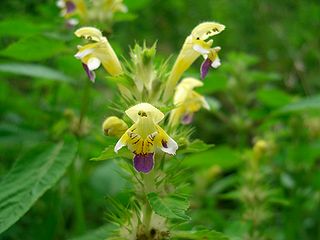
The Lamiales are an order in the asterid group of dicotyledonous flowering plants. It includes about 23,810 species, 1,059 genera, and is divided into about 24 families. Being one of the largest orders of flowering plants, Lamiales have representatives found all over the world. Well-known or economically important members of this order include lavender, lilac, olive, jasmine, the ash tree, teak, snapdragon, sesame, psyllium, garden sage, and a number of table herbs such as mint, basil, and rosemary. Lamiales and Orobanchaceae are both the largest populated parasitic angiosperms of flowering plants.

Ancistrus is a genus of nocturnal freshwater fish in the family Loricariidae of order Siluriformes, native to freshwater habitats in South America and Panama. Fish of this genus are common in the aquarium trade where they are known as bushynose or bristlenose catfish. In the aquarium hobby they are often referred to as bushynose or bristlenose plecos instead, but this may lead to confusion as "pleco" usually is used for Hypostomus plecostomus and its allies and is often used as a catchall term for any loricariids remotely resembling that species.

The genus Pulsatilla contains about 40 species of herbaceous perennial plants native to meadows and prairies of North America, Europe, and Asia. Derived from the Hebrew word for Passover, "pasakh", the common name pasque flower refers to the Easter (Passover) flowering period, in the spring. Common names include pasque flower, wind flower, prairie crocus, Easter flower, and meadow anemone. Several species are valued ornamentals because of their finely-dissected leaves, solitary bell-shaped flowers, and plumed seed heads. The showy part of the flower consists of sepals, not petals.

Reseda, also known as the mignonette, is a genus of fragrant herbaceous plants native to Europe, southwest Asia and North Africa, from the Canary Islands and Iberia east to northwest India. The genus includes herbaceous annual, biennial and perennial species 40–130 cm tall. The leaves form a basal rosette at ground level, and then spirally arranged up the stem; they can be entire, toothed or pinnate, and range from 1–15 cm long. The flowers are produced in a slender spike, each flower small, white, yellow, orange, or green, with four to six petals. The fruit is a small dry capsule containing several seeds.

Breynia is a plant genus in the family Phyllanthaceae, first described in 1776. It is native to Southeast Asia, China, the Indian Subcontinent, Papuasia, Australia, and the island of Réunion.

Linderniaceae is a family of flowering plants in the order Lamiales, which consists of about 25 genera and 265 species occurring worldwide. Vandellia micrantha is eaten in Laos, but tastes bitter. Best known are the wishbone flowers Torenia fournieri and Torenia thouarsii, which are used as bedding plants especially in the tropics. Micranthemum is sold as an aquarium plant when it is called 'baby tears'.
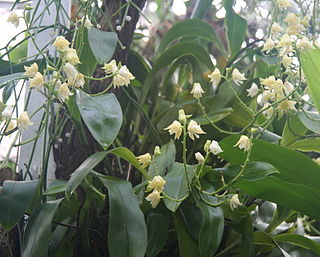
Polystachya, abbreviated Pol in horticultural trade, and commonly known as yellowspike orchid, is a flowering plant genus in the orchid family (Orchidaceae). This rather distinctive genus was described by William Jackson Hooker in 1824 and is the type genus of the subtribe Polystachyinae. It contains about 100 species widespread across many of the tropical areas of the world.
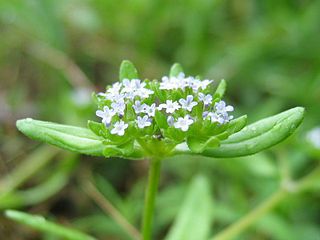
Valerianella is a genus of plant in family Caprifoliaceae. Many plants of this genus are known by the common name corn salad or cornsalad, although that name most often refers to Valerianella locusta.

Zygophyllum is the type genus of the flowering plant family Zygophyllaceae. The generic name is derived from the Greek words ζυγόν (zygon), meaning "double", and φυλλον (phyllon), meaning "leaf". It refers to the leaves, each of which have two leaflets. The genus is distributed in arid and semi-arid regions of Africa, the Mediterranean Basin, central Asia and Australia.

Anemonoides is a genus of flowering plants in the buttercup family Ranunculaceae. Plants of the genus are native to the temperate regions of the Northern Hemisphere, on the continents of North America, Europe, and Asia. The generic name Anemonoides means "anemone-like",, a reminder that many of the species were formerly included within the genus Anemone.
Tridactyle is a genus of flowering plants from the orchid family, Orchidaceae. It has about 60-70 known species, all native to sub-Saharan Africa.

Margelliantha is a genus of flowering plants from the orchid family, Orchidaceae. It consists of 6 known species, all native to eastern and southern Africa.
- Margelliantha burttii(Summerh.) P.J.Cribb - Zaire, Rwanda
- Margelliantha caffra(Bolus) P.J.Cribb & J.Stewart - South Africa
- Margelliantha clavataP.J.Cribb - Tanzania
- Margelliantha globularisP.J.Cribb - Tanzania
- Margelliantha lebeliiEb.Fisch. & Killmann - Rwanda
- Margelliantha leedaliiP.J.Cribb - Tanzania, Kenya

Porpax is a genus of epiphytic orchids native to southern and southeastern Asia from India to Yunnan to Borneo. As of March 2021, Plants of the World Online accepts the following species:
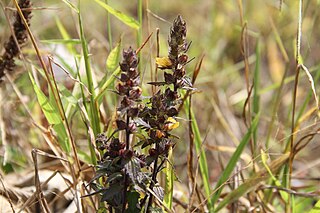
Alectra is a genus of flowering plants in the family Orobanchaceae. It comprises hemiparasitic species.
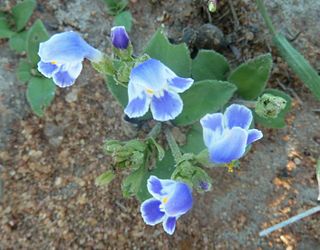
Craterostigma is a genus of shrub-like flowering plants in the family Linderniaceae, found in Africa, Madagascar, Socotra, the Arabian Peninsula, the Indian Subcontinent, Sri Lanka, China, Southeast Asia and Java. The best studied species is the resurrection plant Craterostigma plantagineum, known for its unique drought tolerance.
Szovitsia is a genus of flowering plants belonging to the family Apiaceae.
Bonnaya is a genus of flowering plants belonging to the family Linderniaceae.
Crepidorhopalon is a genus of flowering plants belonging to the family Linderniaceae.













